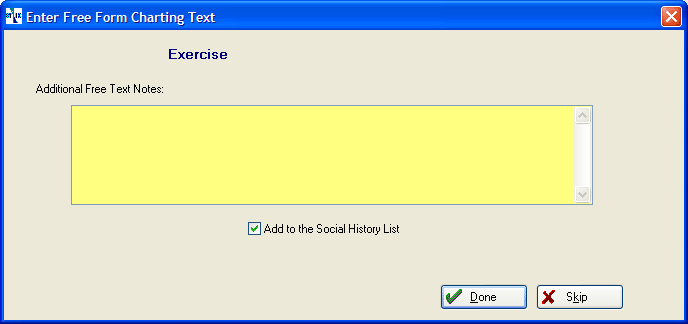Provider Charting Glossary
The Provider Charting Notes function in the Net Health Employee Health and Occupational Medicine uses a number of specialized terms and abbreviations. Some are in common usage in the medical community, such as HPI for History of Present Illness. We have created others to describe the functions of the Net Health Employee Health and Occupational Medicine Charting. Listed below are terms you might need to lookup.
Add Additional Free Text Notes: A checkbox found in the bottom left corner of Wizards which displays a free text entry window when you exit the Wizard to capture notes which the Wizard did not include.

![]()
Alert or Red Flag Warning: A message which can be specified on certain Template Text Elements or Wizards which pops up when that item is executed.
Any Wizard : A button in the bottom left corner of [EMR Charting Template Text Element] windows that allows you to execute any Wizard associated with that Text Element. Variations seen for certain Text Elements include Any Diagnosis, Any Med and Any Med Class.
Check-out Action: An action available for certain Template Text Elements and Wizards which will be taken when that step is executed. A Check-Out Action will create an order record.
Chronicity: A control on certain Text Items and Wizards which speaks to the risk level associated with this particular step. Used in calculating the level of E/M codes.
Clinical Practices Guidelines: Disease, Preventive, and Wellness guidelines consistent with requirement of Drummond. When you set up Clinical Guidelines, criteria are defined for each guideline based on the patient's demographic data or clinical data. These criteria are then used to display alerts for preventive services, tests or counseling that are due for an individual patient.
E/M Codes: Evaluation and Management Codes.
Established Patient: See New Patient below.
Exam Set: A type of Rapid Chart which allows you to select wizards that are associated with Template Elements on the EXAM tab.
Full Charting Note Set:A type of Rapid Chart which supports complete documentation of fairly standard problems. It can include any type of wizard as well as medications.
HPI: History of Present Illness.
MDM: Medical Decision Making.
Rapid Chart: A set of related wizards which can be executed as a unit.
New Patient: This is defined by Medicare as someone you have not seen within the past three years. This is how new versus established is determined for Group Health and Family Practice (i.e. Net Health Employee Health and Occupational Medicine Private Practice). Workers Comp carriers have created a variation in this definition: an initial injury visit is treated as a "new patient", whereas a follow-up visit is treated as "established".
Order Record: Order records are specified by providers and attached to visits. They indicate an action which needs to be taken by someone else, often before the patient leaves the clinic, such as radiology, therapy, or patient instructions.
Order Set: A type of Rapid Charts which can include wizards associated with all types of orders, including medications.
Patient Care Plan: An extension of Clinical Guidelines which allows you to create customized guidelines just for a single patient. These can be modifications of existing guidelines, or they can be created from scratch.
PMH: Patient Medical History.
ROS: Review of Systems.
Specialty Wizards: Wizards designed to collect information which is by nature specific to certain things such as medications, allergies, injuries, and events.
Standard Wizards: General purpose, highly flexible, wizards which are used in most circumstances. The most common type of standard Wizard is a multi-step Wizard which can be set up to collect the exact information needed, and generate the text desired by the provider. It is also possible to create Standard Text Wizards which insert a block of pre-determined verbiage, and Free Form Text Wizards which allow the user to directly enter the needed notes.
Template Element: One small section on a Charting Template. For example, the elements which comprise HPI include Nature of Illness and Quality.
Text Element: This is what comprises the list of possible things to do on a Template Element. A Text Element can trigger a simple brief text, a lengthy set of text statements, the ability to enter free form text, a medication, lab or other kind of order, a clinical result, a CPT coded charge or ICD-9 coded assessment, or what Net Health Employee Health and Occupational Medicine terms a wizard.
Wizard: A user defined automation device which collects the exact information needed for a specific purpose and situation. Wizards are primarily called by Charting Templates when charting notes are generated. However, they have some other applications, such as being attached to a clinical guideline recommendation.